Samuel J. Hughes: Veteran of the Month | April 2024
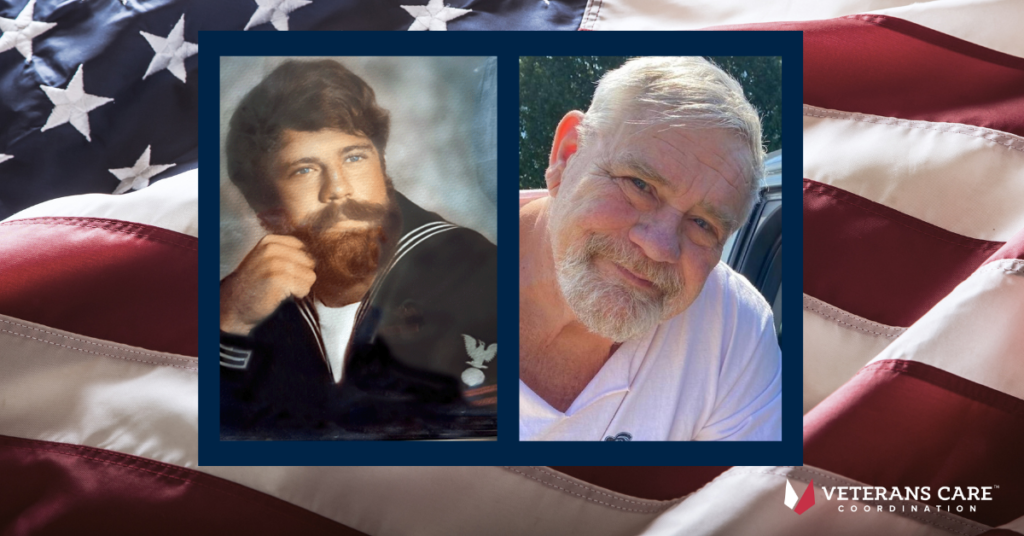
Samuel Jefferson Hughes, named after his grandfathers, was born in St. Louis in 1947. He is the oldest of two boys. His family never stayed in one place very long. Hughes laughed, saying, “We moved a lot; we were gypsies, I guess.” They always lived in the St. Louis area, but he estimates he moved 12 times before starting the fourth grade. His family may not have been wealthy, but his parents always put food on the table and a roof over his head. Hughes stated, “We always had clean clothes and always had what we needed. Every year before we would go to school, we would get two shirts, a pair of pants, and a pair of shoes. Every year.”
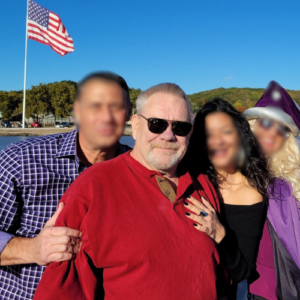
Sam Hughes with friends.
When he was just 14 years old, Hughes started working on paper trucks. He took the job to help contribute to his family, and it taught him the value of hard work. He enjoyed playing baseball and building model cars and planes in his free time. Hughes faced academic challenges in school due to an unknown learning disability at the time, and working with his hands was almost like a form of meditation for him. It was only in the last 15 years that he discovered he had dyslexia. Hughes stated, “I don’t remember struggling at all and always stayed pretty optimistic.”
Hughes graduated from Ritnour High School in 1966 and enrolled in community college. He explained, “I wanted school, and I couldn’t afford to go to college, so I went to Florissant Valley Community College for two years.” He initially planned to become a mechanical engineer but knew he would be drafted soon. To get the opportunity to go further in school, he enlisted in the Navy in 1968. He explained, “I had to join for six years to get to school.” At the time, he got to participate in an enlistment ceremony held on the field at Busch Stadium in St. Louis. Hughes recalled, “I enlisted at Busch Stadium; I guess it was to boost morale or whatever. It was a big ceremony, and we were called the Cardinal Company.” Hughes laughed as he continued, “After that, they put us on a bus and sent us away.”
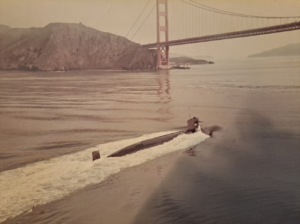
USS Haddock under the Golden Gate Bridge in the early 70s
Upon arrival at the Great Lakes Naval Base for boot camp, Hughes was entrusted with a leadership role as the CPO of his company. He was responsible for maintaining discipline and order. Recalling his duties, Hughes stated, “I was in charge of the guys [which] is a simple way to put it; I called out all of the cadences and got everybody straightened out.”
After completing boot camp, he attended A School at Great Lakes, where he learned electrical engineering, but Hughes was really interested in Nuclear Power School.
At that time, a second-class petty officer was in charge of testing anyone who wanted to attend Nuclear Power School. So Hughes went to talk to him about what he needed to accomplish to get into the school and get the position he was after. Hughes said, “He told me, ‘Be number one in your class, and we will see what we can do.’ And I got the job and got to stay in Chicago for another six or maybe eight months or something like that.” 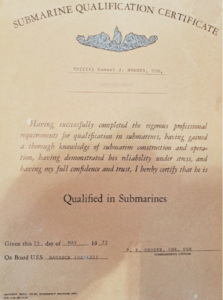
After leaving Chicago, Hughes headed to Vallejo, CA, where he attended a school that he referred to as “paperwork school.” From there, he briefly traveled to Idaho to work on a nuclear reactor in the desert. After completing all of his schooling for Nuclear Power, he received his orders. Fortunately, Hughes was stationed in Hawaii for the next two years, and immediately upon his arrival, his submarine was drydocked. At 21 years of age and having never seen the ocean before going to Vellejo, Hughes would spend the next two years working on a submarine in Hawaii. Hughes exclaimed, “It was like a Cinderella story.”
While stationed in Hawaii, he established a work schedule of five days on, followed by three days off. During the submarine’s two-year drydock period, all its equipment was removed for testing and maintenance before it was scheduled to leave port for its next deployment. He rented a place with a few friends, and when he wasn’t working on the submarine, he wanted to spend time in the water, where he learned to sail and scuba dive. Hughes confessed, “I spent more time in the water than I did on land.”
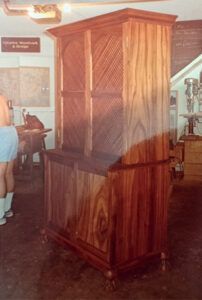
Furniture handcrafted by Sam Hughes.
After spending two years working in Hawaii, he received orders for what the Navy refers to as a WestPac or Western Pacific deployment, which covers the waters around the Western and Central Pacific Ocean. He was assigned to serve on the Haddock (SSN-621), a nuclear-powered Thresher Class Attack Submarine. The Haddock held approximately 300+ people and was 278 feet long, and the beam, the broadest point of a ship, was 31 feet wide.
While working as an electrician on the Haddock, Hughes was responsible for the electric plant control panel and the steam plant propulsion system (SPPS). Hughes explained, “The reactor basically is just a big water heater, so you heat up the water, and it spins the turbines, and that’s how you get propulsion, so my job was to control the big, massive turbines that ran the screw.” After relaying the information, Hughes paused and exclaimed, “Wow, this is nostalgic. This is amazing; I haven’t talked about this in a long time.”
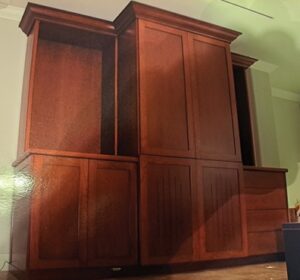
Cabinetry handcrafted by Sam Hughes.
During his WestPac deployment, Hughes shared that the submarine he was on remained submerged for three months. Although the sub can stay submerged for much longer, the crew tries to avoid staying submerged for too long, as it can be challenging for the sailors on board. When asked about the difficulty of staying underwater for such an extended period, Hughes replied, “I didn’t really think about it. I mean, your brain does amazing things, so I just didn’t think about it.” Hughes explained that running out of food and supplies was another challenge of staying submerged for an extended period. Hughes did exclaim, “We ate like kings! Submariners ate the best of all of them. I guess it was one of the things to keep you from going crazy.” According to Hughes, when the submarine left the port, stacks of food boxes blocked every passageway. He had to climb over them to reach his rack to sleep. However, as time passed and food was consumed, it became easier for everyone to move around the hallways. Hughes spent two years on a submarine, traveling to various ports during his WestPac deployment. Hughes stated, “It was fun; I would never do it again, but I am glad I did it. I loved seeing different places and having different experiences.”
After receiving an honorable discharge in 1974, Hughes decided to stay in Hawaii. He lived there for the next 43 years, primarily on Oahu. Hughes, who still loved to work with his hands, began to build cabinets and furniture. He said, “I built a lot of furniture and a lot of cabinets. Cabinets paid the bills. I worked on a lot of stores, built some houses and many, many kitchens.” Building furniture was Hughes’ favorite activity, and he enjoyed working with Koa wood, considered the wood of Hawaiian royalty. According to Hughes, “When you build something, at the end of the day, you can walk away and see the result, and that was the most rewarding part of that whole thing.” Hughes crafted furniture and cabinets by hand, which caught Tom Selleck’s attention while working in the area for the TV show Magnum PI. Eventually, he made furniture and cabinets for Selleck’s house as well as other cast members who were part of the show.
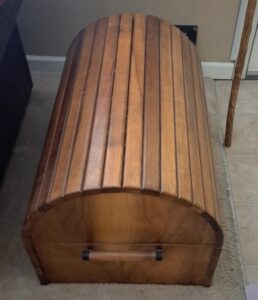
Chest handcrafted by Sam Hughes.
Hughes never got married but always had a woman in his life. He lived with one woman for seven years and developed a strong bond with her three-year-old daughter, Gabby. While living on the water in Hawaii, Hughes had a Hobie Cat sailboat that he could sail right out of his backyard, which he did as frequently as possible. He also constructed a spacious workshop measuring 25′ x 40′ on his property and loved building things there while his dogs kept him company. Hughes shared, “I had my dogs there, and it was utopian. I loved it.”
In 2008, work slowed and became very hard to find. He decided to retire, and then in 2013, he moved back to St. Louis to stay with his ailing mother. Hughes recalled, “I just had to move. I think moving around so much when I was younger, I just had it in my blood.”
In retirement, Hughes likes to spend time reading and writing and is a confessed YouTube addict. He also shared, “I’m not good at finishing poems, but I am good at starting them.” He is enjoying not having a schedule after working since the age of 14. Hughes laughed, saying, “Someone goes, ‘What are you doing today?’ and I said I don’t know, but it took me all day to do it.” When asked what he learned during his time in the Navy, Hughes responded, “Everything.”
Veterans Care Coordination is proud to recognize Sam Hughes for his service to our country. We are privileged to have the opportunity to share the stories of our nation’s heroes. Thank you for your service, Sam, and welcome home.
